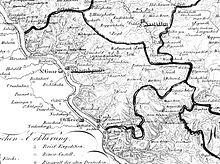Office St. Goarshausen
The St. Goarshausen office , based in Sankt Goarshausen, was one of 28 offices in the Duchy of Nassau , which was newly formed on July 1, 1816 as part of a reorganization of the Nassau administration. At the head of the Office of the Duke stood as a local governor a bailiff .
history
Nassau
The following 27 localities belonged to the St. Goarshausen Office:
- the towns of Sankt Goarshausen , Auel , Bornich , Eschbach , Liigart , Niederwallmenach , Nochern , Patersberg , Reichenberg , Reitzenhain, which were formerly part of the Niedergrafschaft Katzenelnbogen
- the quadrilateral and then to the Niedergrafschaft Katzenelnbogen belonging places Lautert , Oberwallmenach , Rettershain and Weyer
- the two -lordly towns until 1778 and then Nassau-Weilburg : Lipporn , Strüth and Welterod
- the former Kurpfälzischen places Kaub , Dörscheid , Weisel from the office Kaub
- the former Trier villages: Dahlheim , Ehrenthal , Niederkestert , Oberkestert , Prath , Wellmich
- the former imperial knighthood , but contested as such by the Palatinate, Sauerthal
In 1820 the office consisted of 26 parish districts, including 2 cities, 1 town, 23 villages and 76 farms and mills. 2,302 families or 9,222 residents lived in the office. Of these, 6,378 were Protestant, 2,701 were Catholic, 26 Mennonites and 117 Jews.
From 1831 the office also assumed the function of a Rhine customs court.
After the March Revolution in 1848, the administration was reorganized. By law of April 4, 1849, administration and jurisdiction were separated at a lower level in Nassau. The reform came into effect on July 1, 1849. 10 district offices were established for administration , the offices continued as judicial offices (i.e. courts of first instance). The administrative tasks of the St. Goarshausen office were carried out by the Rüdesheim district office , the jurisdiction of the St. Goarshausen justice office. However, the reform was reversed on October 1, 1854, the districts abolished and the previous offices restored.
Prussia
After the Prussian annexation of the Duchy when the new Hesse-Nassau province was divided into districts on February 22, 1867, the St. Goarshausen office became part of the Rheingau district . Only as part of this reorganization will administration and jurisdiction be separated. For the jurisdiction in the first instance, which was previously carried out by the office, the judicial officials in the offices were initially responsible and the St. Goarshausen District Court was formed on September 1, 1867 .
But even after the founding of the district, the previous office structure will be retained. The Royal Ordinance of February 22, 1867 regulated: "The administrative districts as narrower administrative districts exist in their previous limits" The former offices form the three districts of the district. According to § 13 of the district constitution, the districts sent the former offices six representatives to the new district council . The bailiff was in charge of the local police and the district administrator.
With the administrative reform of 1885/1886 the offices were finally dissolved.
Bailiffs
- 1816–1819: Peter Grüsing
- 1819–1820: Heinrich Ernst Hinzpeter
- 1820–1830: Johann Friedrich Schapper
- 1830–1838: Kaspar Hendel
- 1839–1848: Ludwig Christian Schellenberg
- 1848–1849: Ferdinand Vogler
- 1854–1859: Moritz von Gagern
- 1859–1865: Wilhelm Rullmann
- 1865–1874: Friedrich Müller
- 1874–1886: Julius Adolph Schreiber
literature
- Thomas Klein: Volume 11: Hessen-Nassau, the series: Walther Hubatsch: Outline of German Administrative History 1815–1945, 1979, ISBN 3-87969-126-6 , pp. 178–179
Individual evidence
- ^ Ordinance sheet of the Duchy of Nassau, Volume 8 , 1816, p. 106 ( Google Books )
- ↑ Annals of the Society for Nassau Antiquity and Historical Research : Volume 10, 1870, p. 333 ( online )
- ↑ Law of April 4, 1849 (VBl p. 87); Law, the execution of the law on the separation of the administration of justice from the administration in the lower instance on May 31, 1849, (VBl p. 409)
- ↑ Law of July 24, 1854 (Bvl. P. 160)
- ↑ VO of June 26, 1867, GS p. 1094
- ↑ Royal Decree of February 22, 1867 Supplement to the intelligence paper for Nassau of March 11, 1867, § 8 and 9
- ↑ GS 1885, p. 229

